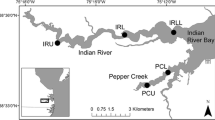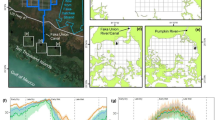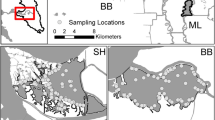Abstract
The South Carolina Estuarine and Coastal Assessment Program (SCECAP) was initiated in 1999 to assess the condition of the state's coastal habitats using multiple measures of water quality, sediment quality, and biological condition. Sampling was subsequently expanded to include components required for the National Coastal Assessment (Coastal 2000) Program. Habitats are classified as either “tidal creeks” (<#60; 100 meters in width) or larger “open water” bodies. Approximately 30 sites are sampled within each habitat during the summer months using a probability-based random sampling design. Results obtained from the first two years of sampling documented significant differences in several water quality parameters (DO, salinity, pH, turbidity, fecal coliform bacteria, total nitrogen, TKN, total phosphorus) and biological measures (chlorophyll-a, finfish and crustacean abundance and biomass and a number of benthic species) between the tidal creek and open water habitats. These differences highlight the value of partitioning shallow water habitats separately from the larger open water bodies traditionally sampled in estuarine monitoring programs, especially since tidal creeks serve as critical nursery areas for many species. Based on the differences observed, there is a clear need to identify different physical and biological thresholds for evaluating the condition of each habitat type.
Similar content being viewed by others
References
Bricker, S.B., Clement, C.G., Pirhalla, D.E., Orlando, S.P., and Farrow, D.R.G.: 1999, National estuarine eutrophication assessment: Effects of nutrient enrichment in the nation's estuaries. NOAA, National Ocean Service, Special Projects Office and the National Centers for Coastal Ocean Science. Silver Spring, MD. 71 pp.
Carlton, J., Brown, J.S., Summers, J.K., Engle, V.D., and Bourgeois, P.E.: 1998, A report on the condition of the estuaries of Alabama in 1993–1995: A program in progress. Alabama Department of Environmental Management, Mobile, AL. 19 pp.
Diaz-Ramos, S., Stevens, D.L., Jr. and Olsen, A.R.: 1996, EMAP statistical methods manual, EPA/620/R-96/002. U.S. Environmental Protection Agency, Office of Research and Development, Office of Research and Development, NHEERL-Western Ecology Division, Corvallis, Oregon.
Dodd, M.G. and Murphy, T.M.: 1996, ‘The status and distribution of wading birds in South Carolina, 1988–1996’, Final report prepared by S.C. Department of Natural Resources, Columbia SC. Submitted to the Charleston Harbor Project, Charleston, SC. 66 pp.
Hackney C.T., Burbanck, W.D., and Hackney, O.P.: 1976, ‘Biological and physical dynamics of a Georgia tidal creek’, Chesapeake Science 17, 271–280.
Holland, A.F., Riekerk, G.H.M., Lerberg, S.B., Zimmerman, L.E., and Sanger, D.M.: 1997, ‘Assessment of the impact of watershed development on the nursery functions of tidal creek habitats’, pp. 110–115 in: Management of Atlantic Coastal Marine Fish Habitat: Proceedings of a Workshop for Habitat Managers, ASMFC Habitat Management Series #2, April 1997. 223 pp.
Hyland, J.L., Balthis, L., Hackney, C.T., McRae, G., Ringwood, A.H., Snoots, T.R., Van Dolah, R.F. and Wade, T.L.: 1998, Environmental quality of estuaries of the Carolinian Province: 1995. Annual statistical summary for the 1995 EMAP Estuaries Demonstration Project in the Carolinian Province. NOAA Technical Memorandum NOS ORCA 123 NOAA/NOS, Office of Ocean Resources Conservation and Assessment, Silver Spring, M.D. 143 pp.
Ogburn, M.V., Allen, D.M. and Michener, W.K.: 1988, Fishes, shrimps, and crabs of the North Inlet Estuary, SC: A four-year seine and trawl survey. Baruch Institute Technical Report No. 88–1. 299 pp. University of South Carolina, Columbia.
Sanger, D.M., Holland, A.F. and Scott, G.I.: 1999a, ‘Tidal creek and salt marsh sediments in South Carolina coastal estuaries. I. Distribution of trace metals’, Environmental Contamination and Toxicology 37, 445–457.
Sanger, D.M., Holland, A.F. and Scott, G.I.: 1999b, ‘Tidal creek and salt marsh sediments in South Carolina coastal estuaries. II. Distribution of organic contaminants’, Environmental Contamination and Toxicology 37, 458–471.
Shenker, J.M. and Dean, J.M.: 1979, ‘The utilization of an intertidal salt marsh creek by larval and juvenile fishes: abundance, diversity and temporal variation’, Estuaries 2, 154–163.
South Carolina Department of Health and Environmental Control.: 1997a, State of South Carolina monitoring strategy for fiscal year 1998. Technical Report No. 002–97, Bureau of Water, Columbia, SC. 77 pp. plus appendices.
South Carolina Department of Health and Environmental Control.: 1997b, Environmental investigations standard operating procedures and quality assurance manual. Office of Environmental Quality Control. Columbia, SC.
South Carolina Department of Health and Environmental Control.: 1997c, Procedures and quality control manual for chemistry laboratories. Analytical Services Division, Bureau of Environmental Services, Columbia, S.C.
South Carolina Department of Health and Environmental Control.: 1998a, Summary of selected water quality parameter concentrations in South Carolina waters and sediments. January 1, 1993–December 31, 1997. Technical Report 004–98. Bureau of Water. Columbia, SC. 122 p.
South Carolina Department of Health and Environmental Control.: 1998b, Water classifications and standards (Regulation 61–68) and classified waters (Regulation 61–69). Office of Environmental Quality Control. 36 pp.
South Carolina Department of Health and Environmental Control.: 2000, Standard operating and quality control procedures for phytoplankton and chlorophyll a. Technical Report No 014–00. 20 pp. plus appendices.
Stevens, D.L., Jr.: 1997, ‘Variable density grid-based sampling designs for continuous spatial populations’, Environmetrics 8, 167–195.
Stevens, D.L., Jr and Olsen, A.R.: 1999, ‘Spatially restricted surveys over time for aquatic resources’, Journal of Agricultural, Biological, and Environmental Statistics 4, 415–428.
Strobel, C.J., Buffum, H.W., Benyi, S.J., Petrocelli, E.A., Reifsteck, D.R. and Keith, D.J.: 1995, Statistical summary EMAP-Estuaries Virginian Province-1990 to 1993, EPA/620/R-94/026. U.S. Environmental Protection Agency, National Health and Environmental Effects Research Laboratory, Atlantic Ecology Division, Narragansett, RI, 72 pp.
Summers, J.K., Macauley, J.M., Heitmuller, P.T, Engle, V.D., Adams, A.M. and Brooks, G.T.: 1993, Annual statistical summary: EMAP-Estuaries Louisianian Province-1991. EPA/600/R-93/001. U.S. Environmental Protection Agency, Office of Research and Development, Environmental Research Laboratory, Gulf Breeze, FL, 101 pp. plus appendices A-C.
USEPA (U.S. Environmental Protection Agency): 1999, Draft ambient water quality criteria for dissolved oxygen (saltwater): Cape Cod to Cape Hatteras, EPA 822–D-99–002, U.S. Environmental Protection Agency, Office of Water, 55 pp. plus appendices.
Van Dolah, R.F., Chestnut, D.E. and Scott, G.I.: 2000, A baseline assessment of environmental and biological conditions in Broad Creek and the Okatee River, Beaufort County, South Carolina. Final Report to the Beaufort County Council, Beaufort County, South Carolina. 281 pp.
Weinstein, M.P.: 1979, ‘Shallow marsh habitats as primary nurseries for fishes and shellfish, Cape Fear River, North Carolina’, Fisheries Bulletin 77, 339–357.
Author information
Authors and Affiliations
Rights and permissions
About this article
Cite this article
Van Dolah, R.F., Chestnut, D.E., Jones, J.D. et al. The Importance of Considering Spatial Attributes in Evaluating Estuarine Habitat Condition: The South Carolina Experience. Environ Monit Assess 81, 85–95 (2003). https://doi.org/10.1023/A:1021312621772
Issue Date:
DOI: https://doi.org/10.1023/A:1021312621772




